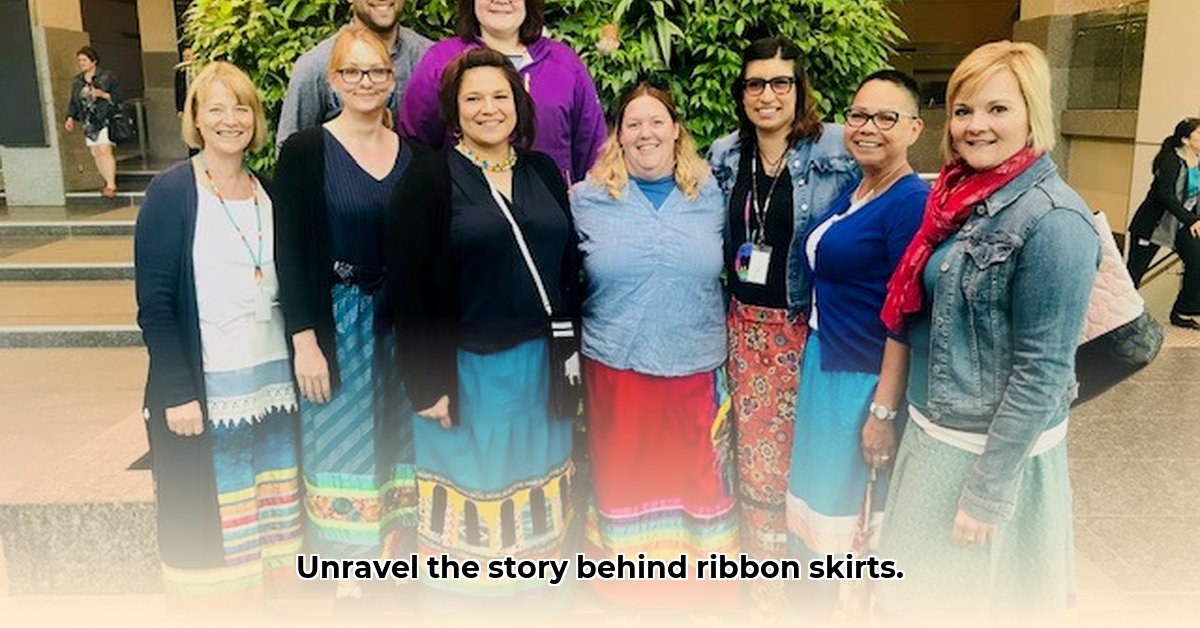Unveiling the Enduring Cultural Significance
The ribbon skirt transcends mere fashion; it stands as a profound emblem of Indigenous history, resilience, and cultural identity. A vibrant tapestry of designs and colors reflects the diverse narratives of Indigenous nations, embodying their unique heritage and traditions. The creation of these skirts requires considerable time, skill, and a deep spiritual connection, underscoring the importance of respecting this cherished art form. By understanding and supporting Indigenous creators, we ensure the proper appreciation and preservation of these invaluable cultural treasures, especially in light of historical traumas such as the violence against Indigenous women.
Tracing the Threads of Origin and Evolution
Identifying the precise origins of the ribbon skirt presents a challenge due to historical gaps and suppression during colonization. Indigenous peoples traditionally crafted clothing from natural materials, sustainably sourced from their surroundings. The arrival of European traders introduced colorful ribbons and beads, which Indigenous artisans creatively integrated into their existing practices. These changes fashioned the ribbon skirts we recognize today and serve as a testament to their resilience in the face of colonialism. This fusion of tradition and innovation showcases the ingenuity, adaptability, and enduring spirit of Indigenous cultures.
Exploring the Rich Tapestry of Regional Variations and Styles
The beauty of the ribbon skirt lies in its incredible diversity, as each Indigenous nation showcases its own distinct style. These variations are found in the number of ribbons, color combinations, patterns, embellishments, and overall design aesthetic reflecting clan affiliations, family stories, personal narratives, and spiritual beliefs. No two skirts are exactly alike; each serves as a unique reflection of its wearer’s heritage, journey, and identity. These regional variations remind us of the vastness of Indigenous traditions and artistic vision across Turtle Island.
Decoding the Language of Colors, Patterns, and Embellishments
The colors, patterns, and embellishments are laden with meaning, extending far beyond mere aesthetics. Colors often represent the four cardinal directions, specific clans, family lineages, or elements such as water, fire, earth, and sky. Intricate patterns tell stories passed down through generations, filled with history, ancestral wisdom, and teachings. Each skirt functions as a silent storyteller, embodying ancestral knowledge, with stories that are important to carry forward during cultural revitalization movements.
Ribbon Skirts: Contemporary Symbols of Strength, Resistance, and Reclamation
Today, the ribbon skirt symbolizes cultural revitalization, resistance, and reclamation. For many Indigenous women, wearing a ribbon skirt reclaims their identity, honors their ancestors, and resists historical injustices such as residential schools and the Missing and Murdered Indigenous Women and Girls (MMIW) crisis. Wearing a ribbon skirt is a powerful statement of cultural pride, strength, and resilience in the face of adversity, demonstrating a profound commitment to cultural revitalization and self-determination.
The Spiritual and Cultural Significance of Creating a Ribbon Skirt
Creating a ribbon skirt is a deeply spiritual and cultural practice transcending the act of sewing. Passed down through families, each stitch carries generations of knowledge, tradition, and love. The act of creation allows Indigenous women to reconnect with their heritage, honor their ancestors, strengthen community bonds, and express their individual creativity. This exemplifies a powerful and tangible link to the past, present, and future.
Promoting Respect, Understanding, and Ethical Engagement
Appreciating the beauty of a ribbon skirt requires understanding its deeper significance, especially for those outside Indigenous communities. Combating cultural appropriation and celebrating the artistry and cultural knowledge embodied in each skirt is crucial, ensuring that the stories and traditions are honored and respected. Supporting Indigenous artisans, ensuring fair compensation, and promoting ethical practices within the fashion industry are essential, while learning, asking respectful questions, and amplifying Indigenous voices are equally important.
Actionable Steps for Fostering Respectful Engagement
To foster a future where Indigenous cultures are respected, celebrated, and protected, individuals, organizations, and institutions can take specific actions:
- Indigenous Communities: Support local craft workshops, cultural events, and storytelling initiatives to preserve, promote, and revitalize cultural traditions. Create platforms for intergenerational knowledge sharing and mentorship.
- Researchers & Academics: Conduct research with Indigenous communities, prioritizing their voices, knowledge, and self-determination, rather than conducting research on them. Ensure that research projects are community-led, culturally relevant, and ethically sound.
- Fashion Industry: Partner respectfully with Indigenous designers, adhering to fair trade practices to ensure equitable compensation, cultural preservation, and authentic representation. Avoid cultural appropriation by seeking guidance from Indigenous communities and respecting intellectual property rights.
- Educational Institutions: Integrate the study of the ribbon skirt and Indigenous cultures into curricula across disciplines. Develop educational resources that promote understanding, appreciation, and respect for Indigenous knowledge, histories, and perspectives. Partner with Indigenous communities to create culturally responsive educational programs.
- Governments & Policy Makers: Fund Indigenous arts and cultural preservation programs, enacting and enforcing laws that protect Indigenous intellectual property and cultural heritage. Support Indigenous-led initiatives that promote cultural revitalization, language preservation, and economic development.
The ribbon skirt symbolizes resilience, cultural identity, and the enduring spirit of Indigenous women. Honoring its significance and the rich cultural heritage it represents requires a collective and sustained effort.
Ethical Considerations in Ribbon Skirt Production and Distribution: A Guide to Respectful Practices
Understanding the Ribbon Skirt’s Profound Significance
The ribbon skirt is more than just an article of clothing; it is a living symbol of resilience, spirituality, and cultural identity, embodying vibrant narratives through carefully chosen colors, patterns, and materials. Decorations often symbolize clan affiliations, family history, and personal journeys. Understanding these symbolic meanings is crucial before ethically sourcing materials and engaging with this sacred garment, ensuring that the practice is carried out with utmost respect for traditions.
Historical Context: Tracing the Origins and Evolution
The ribbon skirt’s origins are complex, dating back to pre-European contact when Indigenous peoples utilized available materials to create clothing that reflected their unique cultural identities. The introduction of trade goods like ribbons presented new aesthetic possibilities, leading to a blending of traditional techniques and new elements. This evolution demonstrates adaptation and cultural survival in the face of colonization, and this historical context is essential for understanding the ethical implications of engaging with ribbon skirts today.
Recognizing Regional Diversity: Celebrating Unique Cultural Expressions
Indigenous cultures exhibit incredible diversity in ribbon skirt designs, with each nation possessing unique artistic traditions that influence their choice of colors, materials, patterns, and embellishments. There is no single “traditional” style; generalized patterns risk cultural appropriation and misrepresentation. A Plains ribbon skirt differs significantly from one crafted on the Northwest Coast, underscoring the importance of respecting these varying cultural traditions and avoiding homogenization.
Unraveling the Narrative: Decoding the Symbolism of Color and Design
Colors and patterns are not arbitrary; they hold deep spiritual and symbolic meanings that represent clans, natural elements, personal stories, or important teachings. The creation of each skirt is a powerful expression of cultural identity, heritage, and resilience. Thoroughly researching and understanding the specific symbolism is vital before creating or distributing ribbon skirts, ensuring that the intended meanings are honored and respected.
A Practical Guide to Ethical Sourcing for Indigenous Ribbon Skirts
Ethical sourcing requires a deep respect for Indigenous communities, their intellectual property, and their cultural protocols.
- Thorough Research: Identify the specific Indigenous nation whose traditions you aim to represent, seeking guidance from Indigenous sources and knowledge keepers to avoid assumptions, stereotypes, and misrepresentations.
- Direct Sourcing: Purchase materials directly from Indigenous-owned businesses, artisans, and cooperatives to ensure fair compensation and support cultural preservation and economic empowerment within Indigenous communities.
- Traditional and Sustainable Materials: Prioritize the use of traditional materials whenever possible, while also considering the environmental impact of your choices. Opt for sustainable and ethically sourced materials that align with Indigenous values and environmental stewardship.
- Respectful Collaboration: Collaborate directly with Indigenous artisans, designers, and knowledge keepers to ensure that their expertise, perspectives, and cultural protocols are respected and incorporated throughout the design and production process. Foster genuine partnerships based on mutual trust, respect, and reciprocity.
- Avoid Cultural Appropriation: Refrain from copying designs without explicit permission from the originating Indigenous community, as these designs hold deep cultural significance and are often protected by intellectual property rights. Educate yourself about cultural appropriation and take steps to avoid perpetuating harmful stereotypes or disrespectful practices.
- Transparency and Acknowledgment: Be transparent about your sourcing, production, and distribution practices, openly acknowledging the cultural origins of the ribbon skirt designs and the contributions of Indigenous artisans. Provide attribution to the specific Indigenous nation or community that inspired your work.
The Modern Ribbon Skirt: A Symbol of Cultural Pride and Resistance
Today, the ribbon skirt embodies reclamation, resilience, and self-determination, serving as a powerful symbol of Indigenous women’s strength, cultural pride, and resistance against historical injustices. Ethical Considerations in Ribbon Skirt Production and Distribution are paramount to ensure that this sacred garment is revered and respected for its cultural significance. Engaging with this art form respectfully requires a commitment to learning, understanding, and ethical action.
Ribbon Skirt Design and Symbolism Across Turtle Island: Honoring Regional Variations
A Tapestry of Traditions: Celebrating Indigenous Identity
Ribbon skirts are powerful expressions of Indigenous identity, with their beauty residing in the profound stories they tell. Each skirt whispers tales of ancestry, spirituality, community connection, and personal journeys. A rich kaleidoscope of colors and patterns reflects the remarkable diversity of Indigenous cultures across Turtle Island, demonstrating cultural pride, resilience, and self-determination.
Historical Echoes: Unveiling the Origins and Evolution
Pinpointing the exact origins of the ribbon skirt remains a challenge, but its story unfolds over centuries, shaped by both tradition and adaptation. Early designs incorporated readily available materials, reflecting the resourcefulness and ingenuity of Indigenous peoples. The introduction of European textiles and ribbons presented new possibilities for artistic expression, leading to the
- Gray Kitchen Backsplash Tile: Ideas for a Stylish Upgrade - December 14, 2025
- Backsplash For Gray Cabinets: Choosing the Right Backsplash Style - December 13, 2025
- Gray And White Backsplash: Ideas For Timeless Style - December 12, 2025









